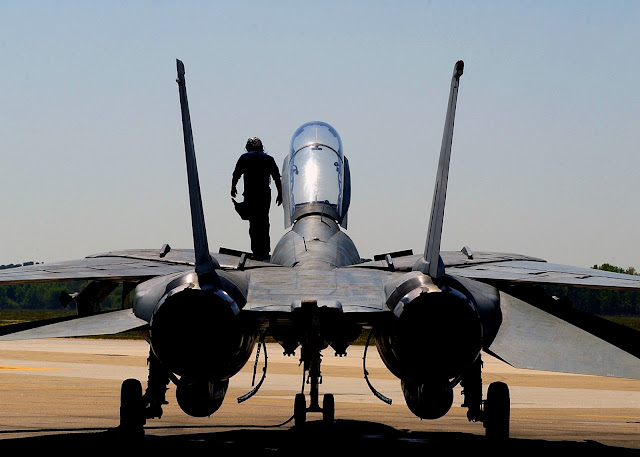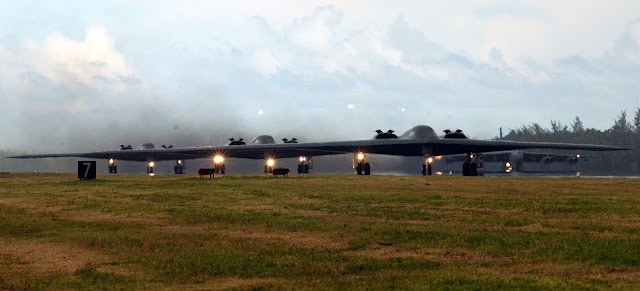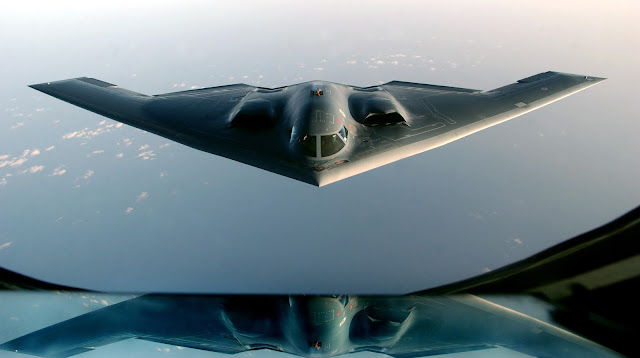The Grumman F-14 Tomcat is a supersonic, twin-engine, two-seat, variable-sweep wing fighter aircraft. The Tomcat was developed for the United States Navy's Naval Fighter Experimental (VFX) program following the collapse of the F-111B project.
The F-14 was the first of the American teen-series fighters which were designed incorporating the experience of air combat against MiG fighters during the Vietnam War.
The F-14 first flew in December 1970 and made its first deployment in 1974 with the U.S. Navy aboard USS Enterprise (CVN-65), replacing the McDonnell Douglas F-4 Phantom II.
The F-14 served as the U.S. Navy's primary maritime air superiority fighter, fleet defense interceptor and tactical reconnaissance platform. In the 1990s, it added the Low Altitude Navigation and Targeting Infrared for Night (LANTIRN) pod system and began performing precision ground-attack missions.
The Tomcat was retired from the U.S. Navy's active fleet on 22 September 2006, having been supplanted by the Boeing F/A-18E/F Super Hornet.
As of 2012, the F-14 was only in service with the Islamic Republic of Iran Air Force, having been exported to Iran in 1976, when the U.S. had amicable diplomatic relations with Iran's government. Source |
| A plane captain conducts a daily inspection of his F-14D Tomcat that is assigned to the “Tomcatters” of Fighter Squadron Three One (VF-31). Lincoln and Carrier Air Wing Fourteen (CVW 14) are conducting combat operations in support of Operation Southern Watch. U.S.Navy photo by Photographer's Mate 3rd Class Philip A. McDaniel. |
 |
| An F-14D “Tomcat” assigned to the "Bounty Hunters" of Fighter Squadron Two (VF-2) flies over the ship’s flight deck during Christmas morning flight operations. Constellation is on a regularly scheduled deployment conducting combat missions in support of Operation Enduring Freedom. U.S. Navy photo by Photographer's Mate 2nd Class Felix Garza Jr. |
 |
| A Flight Deck Director guides an F-14D “Tomcat” assigned to Fighter Squadron Three One (VF-31) onto catapult one for its next catapult launch. VF-31 and other elements belonging to Carrier Air Wing Fourteen (CVW-14) are flying combat missions over Southern Iraq in support of Operations Southern Watch and Enduring Freedom. U.S. Navy photo by Photographer's Mate 3rd Class Philip A. McDaniel. |
 |
| A flight deck crewmember guides an F-14D “Tomcat” assigned to the “Bounty Hunters” of Fighter Squadron Two (VF-2) onto one of four steam driven catapults on the ship’s flight deck. This is the last cruise for the Bounty Hunters, as their squadron will be decommissioned along with the Constellation after this deployment. Constellation is on a regularly scheduled six-month deployment conducting combat missions in support of Operation Enduring Freedom. U.S. Navy photo by Photographer’s Mate 2nd Class Richard Moore. |
 |
| An F-14D “Tomcat” assigned to the “Tomcatters” of Fighter Squadron Thirty-One (VF-31), part of Carrier Air Wing Fourteen (CVW-14) conducts a combat mission in support of Operation Southern Watch. The “Tomcatters” and CVW-14 are aboard the USS Abraham Lincoln (CVN 72) during their regularly scheduled six-month deployment in support of Operations Enduring Freedom and Southern Watch. U.S. Navy photo by Lt. Cmdr. Jim Muse. |
 |
| Hanger Deck Crew move a F-14D Tomcat assigned to the “Bounty Hunters” of Fighter Squadron Two (VF-2) onto one of four aircraft elevators aboard USS Constellation (CV 64). Constellation and Carrier Air Wing Two (CVW-2) are deployed in support of Operation Iraqi Freedom. Operation Iraqi Freedom is the multinational coalition effort to liberate the Iraqi people, eliminate Iraq's weapons of mass destruction and end the regime of Saddam Hussein. U.S. Navy photo by Photographer's Mate 2nd Class Daniel J. McLain. |
 |
| At sea with USS Constellation (CV 64) May 13, 2003 -- During a rehearsal for Constellation's upcoming Tiger Cruise, an F-14D Tomcat assigned to the “Bounty Hunters” of Fighter Squadron Two (VF-2) makes a high-speed turn in full afterburner while passing by the Constellation. Constellation and Carrier Air Wing Two (CVW-2) are returning to homeport following their deployment in support of Operations Enduring and Iraqi Freedom. U.S. Navy photo by Photographer's Mate 2nd Class Daniel J. McLain. |
 |
| An F-14D Tomcat assigned to the "Tomcatters" of Fighter Squadron Three One (VF-31) ignites its after burners following a launch from the flight deck of USS John C. Stennis (CVN 74). Stennis and her embarked Carrier Air Wing Fourteen (CVW-14) are at sea conducting Composite Training Unit Exercise (COMPTUEX) in preparation for an upcoming deployment. U.S. Navy photo by Photographer's Mate 3rd Class Mark J. Rebilas. |
 |
| An F-14D Tomcat assigned to the "Tomcatters" of Fighter Squadron Three One (VF-31) makes an arrested landing aboard USS John C. Stennis (CVN 74). Stennis and her embarked Carrier Air Wing Fourteen (CVW-14) are at sea conducting Composite Training Unit Exercise (COMPTUEX) in preparation for an upcoming deployment. U.S. Navy photo by Photographer's Mate 3rd Class Mark J. Rebilas. |
 |
| A pair of F-14D Tomcats assigned to the “Bounty Hunters” of Fighter Squadron Two (VF-2) conduct a fly-by of the aircraft carrier USS Constellation (CV 64) with special messages for the upcoming Army vs. Navy Football Game. Constellation and Carrier Air Wing Two (CVW-2) are currently on deployment in support of Operations Enduring Freedom and Southern Watch. U.S. Navy photo by Photographer’s Mate 3rd Class Daniel J. McLain. |
 |
| Aviation Structural Mechanic 3rd Class Dustin Wolfe, of Indianapolis, Ill., completes a pre-flight check on an F-14D Tomcat assigned to the "Tomcatters" of Fighter Squadron Three One (VF-31). U.S. Navy photo by Photographer's Mate 2nd Class J. Scott Campbell. |
 |
| An F-14D Tomcat assigned to the "Tomcatters" of Fighter Squadron Three One (VF-31) sits on the flight deck aboard USS John C. Stennis (CVN 74) as the setting sun silhouettes the jet. Stennis and embarked Carrier Air Wing Fourteen (CVW-14) are currently participating in Exercise Northern Edge while on a scheduled deployment. U.S. Navy photo by Photographer's Mate 2nd Class Jayme Pastoric |
 |
| An F-14D Tomcat assigned to the "Bounty Hunters" of Fighter Squadron Two (VF-2) pulls out of a dive after a practice 20mm gun-strafing demonstration pass for the upcoming "Tiger Cruise," to be held aboard USS Constellation (CV 64). Constellation and embarked Carrier Air Wing Two (CVW-2) are on a regularly scheduled deployment in support of Operation Iraqi Freedom (OIF), the multinational coalition effort to liberate the Iraqi people, eliminate Iraq's weapons of mass destruction and end the regime of Saddam Hussein. U.S. Navy photo by Photographer's Mate 2nd Class Daniel J. McLain |
 |
| The sun sets behind a pair of F-14D Tomcats assigned to the "Tomcatters" of Fighter Squadron Three One (VF-31) as they are prepared to be sent down to the hangar bay aboard the Nimitz-class aircraft carrier USS John C. Stennis (CVN 74). Stennis and embarked Carrier Air Wing Fourteen (CVW-14) are currently participating in a scheduled deployment to the Western Pacific Ocean. U.S. Navy photo by Photographer's Mate 3rd Class Mark J. Rebilas |
 |
| An F-14D Tomcat, assigned to the "Grim Reapers" of Fighter Squadron One Zero One (VF-101), conducts a high-speed flyby causing vapor to form during its tactical flight demonstration at the 2005 Naval Air Station Oceana Air Show. The last F-14 Tomcat flight demonstration will be flown at the air show as the aircraft is phased-out of the Navy’s inventory. The air show, held Sept. 16-18th, showcased civilian and military aircraft from the Nation's armed forces, which provided many flight demonstrations and static displays. U.S. Navy photo by Photographer's Mate 2nd Class Daniel J. McLain |
 |
| An F-14D Tomcat, assigned to the “Blacklions” of Fighter Squadron Two One Three (VF-213), conducts aerial refueling with a U.S. Air Force KC-10 Extender during a mission over the Persian Gulf. VF-213 is assigned to Carrier Air Wing Eight (CVW-8), currently embarked aboard the Nimitz-class aircraft carrier USS Theodore Roosevelt (CVN 71). U.S. Navy photo by Lt.j.g. Scott Timmester |
 |
| An F-14D Tomcat, assigned to the “Blacklions” of Fighter Squadron Two One Three (VF-213), holds in the landing pattern with its tailhook down after conducting a late evening mission over the Persian Gulf region. VF-213 is assigned to Carrier Air Wing Eight (CVW-8), currently embarked aboard the Nimitz-class aircraft carrier USS Theodore Roosevelt (CVN 71). U.S. Navy photo by Lt.j.g. Scott Timmester |
 |
| An F-14D Tomcat, assigned to the “Blacklions” of Fighter Squadron Two One Three (VF-213), conducts a mission over the Persian Gulf. VF-213 is assigned to Carrier Air Wing Eight (CVW-8), currently embarked aboard the Nimitz-class aircraft carrier USS Theodore Roosevelt (CVN 71). U.S. Navy photo by Lt.j.g. Scott Timmester |




















































